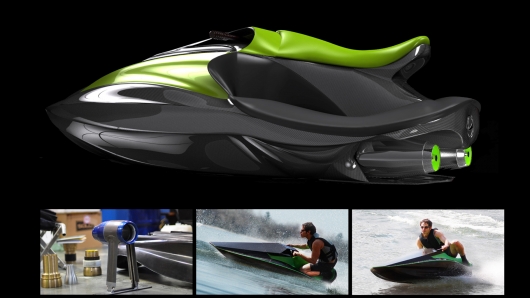
You’re looking at the first exclusive images of what we expect to become the Personal Water Craft V 3.0 – it’s the Green Samba. It has the same straight line 65 mph performance of the fastest 260 bhp sit-down PWCs, combined with handling and agility far beyond those of a stand-up PWC. The biggest benefit though, is that the Green Samba uses twin direct drive electric propulsion pods (unit pictured bottom left), so it doesn’t directly deliver any hydrocarbons, CO2 or NO2 into delicate marine environments. Equally as important as the lack of noxious gases, the Green Samba is also completely silent, removing one of the greatest causes for complaint against PWCs and no doubt offering respite for those creatures with extremely delicate hearing which live on and under the water. A working prototype of the carbon fiber construction Green Samba will be on the water for testing purposes in Q3, 2010. The pictured action shots (bottom center and bottom right) of the Samba are the most recent development of the internal combustion Carbon Samba we first wrote up this time last year.
Things have been extremely busy at Ohio-based Silveira Group, a design and composites company founded by Rodrigo and Kristen Silveira that specializes in carbon fiber components for high performance applications ranging from race car parts and sulkies for horse racing (trotting) through to high end consumer products such as lightweight suitcases. Silveira Group has been working for five years on a tiny stingray-shaped PWC named the Samba. We first reported on the development of the Samba this time last year and that article should be read in conjunction with this one for the full picture. The Samba looks like a stingray and is ridden in a motorcycle-like crouch and was developed with the specific intent of creating the PWC V 3.0.
The basic premise was that existing PWCs began in a different era – when the now familiar form factors of the sit-down and stand-up PWC were penned, gasoline was far more plentiful and much cheaper, and environmental concerns were the domain of tree-huggers and ecological extremists. From the outset, Silveira’s aim was to create a small and lightweight craft capable of changing direction easily, of offering extreme performance from a modest power output because it had less mass to accelerate.
When we wrote up the Samba in April 2009, it had already been through four prototypes, and several more have seen the water since then. The latest iteration has seen the shape and construction refined to such an extent that according to Rodrigo Silveira, just 65 bhp is now required to match the performance of the biggest 240-260 bhp Sea-Doo, Kawasaki and Yamaha designs. But the aim had also been to eventually replace the 800cc twin-cylinder internal combustion engines the company was using in the development process with electric propulsion.
In the last twelve months, the company almost gave up on that process. “I can tell you that making a green watercraft is not easy,” Silveira told Gizmag.
“Our experiments were becoming more discouraging. We knew that the public would not accept lesser performance to go green – being a good citizen does not compensate for being ten mph slower than your friends on their internal combustion skis.
“We wanted to use an electric motor but the amount of energy required to get a jet ski on the plane was so large that it was using too much of the battery capacity. Combustion engines give you the torque you need to get to planing very quickly, without using too much of the available stored energy. We refined everything we could but to get the engine performance we wanted, and sufficient range, we would have needed 150 pounds of batteries which would have impinged on the weight and hence maneuverability too much. We had some sleepless nights wondering if our objectives were achievable with the current state of battery technology.”
As the man who split the atom is oft quoted, “we didn’t have any money, so we had to think” and it was in going back to the objective and rethinking it that the breakthrough came for Rodrigo. With limited resources and the high burn-rate of funds associated with intensive R&D, Silveira acknowledges that he was on the verge of giving up when the breakthrough came.
“We realized that we had been focusing on the motor, not the pump. In the same way that automotive electric propulsion is just about to go through a revolution of design because it doesn’t require the same centrally located ICE we have had for the last 100 years, we began exploring what could be achieved with different propulsion methods.”
“Once we began looking, we came across a propulsion technology originally developed for military applications that had not been previously used in watercraft and we have now acquired an exclusive license for using the technology on watercraft. After testing, we are now confident it makes our objectives possible both weight and price wise.







